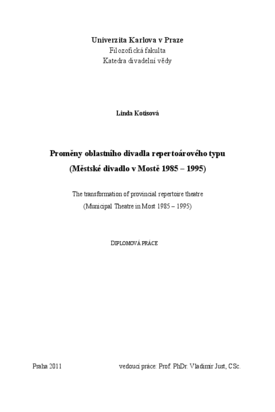Proměny oblastního divadla repertoárového typu (Městské divadlo v Mostě 1985-1995)
The transformation of provincial repertoire theatre (Municipal Theatre in Most 1985-1995)
diplomová práce (OBHÁJENO)

Zobrazit/
Trvalý odkaz
http://hdl.handle.net/20.500.11956/49441Identifikátory
SIS: 95675
Kolekce
- Kvalifikační práce [23779]
Autor
Vedoucí práce
Oponent práce
Topolová, Barbara
Fakulta / součást
Filozofická fakulta
Obor
Divadelní věda
Katedra / ústav / klinika
Katedra divadelní vědy
Datum obhajoby
12. 9. 2011
Nakladatel
Univerzita Karlova, Filozofická fakultaJazyk
Čeština
Známka
Dobře
Klíčová slova (česky)
Lubomír Poživil, Divadlo pracujících v Mostě, ing. Ivo Klimeš, Rudolf Felzmann, Zbyněk Srba, Pavel Pecháček, Vlastimil Novák, sametová revoluce, Občanské fórum, totalitní režim, inscenace, režieKlíčová slova (anglicky)
Lubomír Poživil, The Workers' theatre in Most, Ing. Ivo Klimeš, Rudolf Felzmann, Zbyněk Srba, Pavel Pecháček, Vlastimil Novák, Velvet Revolution, Civil Forum, totalitarian regime, play, directionTato diplomová práce se zabývá desetiletím Městského divadla v Mostě v období 1985 -1995. Začátek práce se soustředí na vývoj divadelnictví na Mostecku od počátků až do 80. let 20. století. Poté je část diplomové práce věnována stavbě a podobě nové divadelní budovy architekta Iva Klimeše, dále příchodu režiséra Zbyňka Srby do Divadla pracujících v Mostě a s ním i studentů DAMU a několika klíčovým inscenacím na mosteckém jevišti v období 1985-1995. Zvláštní kapitola se zaměřuje na sametovou revoluci a její průběh v mosteckém divadle.
This diploma thesis deals with the decade of the Municipal theatre Most's existence in the years 1985 -1995. The first part of my thesis concentrates on the evolution of the theater making in Most region from the very beginning till the 80ties of the 20th century. The second part is dedicated to the construction and the final appearance of the theatre building by the architect Ivo Klimeš, then it describes The Workers' theatre in Most at the time of the director Zbyněk Srba's arrival accompanied by DAMU students and introduces some crucial plays on Most's stage in the years 1985-1995. Special chapter focuses on the Velvet Revolution and its influence on the Theatre Most.
